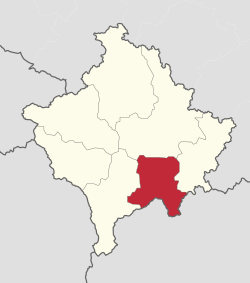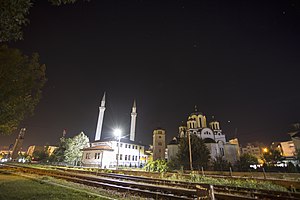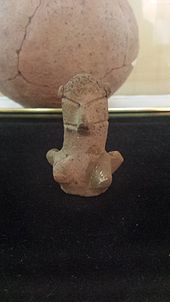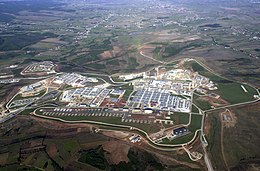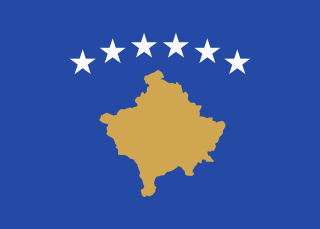
Kosovo, officially the Republic of Kosovo is a country in Southeast Europe with partial diplomatic recognition. Kosovo lies landlocked in the centre of the Balkans, bordered by Serbia to the north and east, North Macedonia to the southeast, Albania to the southwest, and Montenegro to the west. Most of central Kosovo is dominated by the vast plains and fields of Metohija and the Kosovo field. The Accursed Mountains and Šar Mountains rise in the southwest and southeast, respectively. Its capital and largest city is Pristina.

The Vardar Banovina, or Vardar Banate, was a province (banate) of the Kingdom of Yugoslavia between 1929 and 1941.
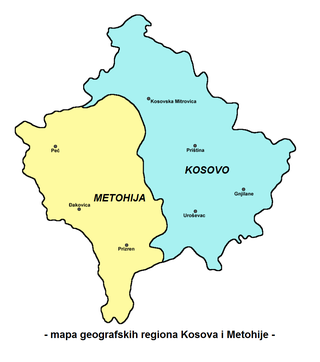
Metohija or Dukagjin is a large basin and the name of the region covering the southwestern part of Kosovo. The region covers 35% (3,891 km2) of Kosovo's total area. According to the 2011 census, the population of the region is 700,577.
The history of Kosovo dates back to pre-historic times when the Starčevo culture, Vinča culture, Bubanj-Hum culture, and Baden culture were active in the region. Since then, many archaeological sites have been discovered due to the abundance of natural resources which gave way to the development of life.

Kaçanik or Kačanik, is a town and municipality located in the Ferizaj District of southern Kosovo. According to the 2011 census, the town of Kaçanik has 15,634 inhabitants, while the municipality has 33,409 inhabitants.
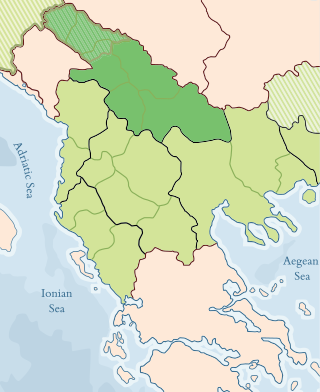
The Vilayet of Kosovo was a first-level administrative division (vilayet) of the Ottoman Empire in the Balkan Peninsula which included the current territory of Kosovo and the north-western part of the Republic of North Macedonia. The areas today comprising Sandžak (Raška) region of Serbia and Montenegro, although de jure under Ottoman control, were in fact under Austro-Hungarian occupation from 1878 until 1909, as provided under Article 25 of the Treaty of Berlin. Üsküb (Skopje) functioned as the capital of the province and the midway point between Istanbul and its European provinces. Üsküb's population of 32,000 made it the largest city in the province, followed by Prizren, also numbering at 30,000.
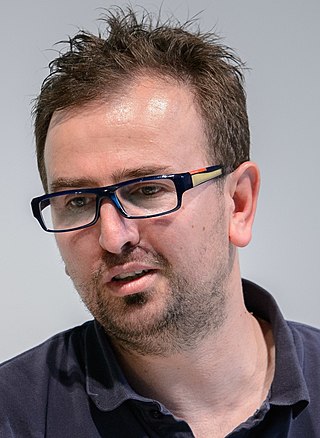
Jeton Neziraj is a playwright from Kosovo. He was the Artistic Director of the National Theatre of Kosovo and now he is the Director of Qendra Multimedia, a cultural production company based in Prishtina.

Pristina is the capital and largest city of Kosovo. It is the administrative center of the eponymous municipality and district.
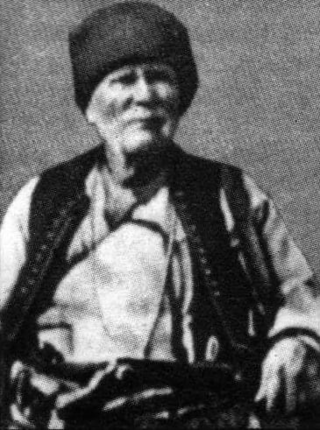
Idriz Seferi was an Albanian leader and guerrilla fighter (rebel). During his 56 year military career, he fought in 35 battles. A member of the League of Prizren and League of Peja, he was the right-hand man of Isa Boletini, with whom he organized the 1910 Uprising against the Ottoman Empire in the Kosovo Vilayet. After the suppression of the uprising, Seferi continued warfare, in the 1912 Uprising. In the First Balkan War, Boletini and Seferi rose up against Serbia, with whom they had previously been allies to during the 1910 and 1912 Uprisings, and continued to attack Serbian posts in the subsequent occupation and initial phase of World War I (1913-1915). In the second phase of the war (1916-1918), he led troops against Bulgarian forces.

Transport in Kosovo consists of transport by land and air. After the Kosovo's independence, improvements to the road infrastructure, urban transport, and air travel have all led to a vast improvement in transportation. These upgrades have played a key role in supporting Kosovo's economy.
This is a timeline containing events regarding the history of Kosovo.

The Kingdom of Serbia was one of the major parties in the Balkan Wars, gaining land in both conflicts. It experienced significant territorial gains in the Central Balkans, nearly doubling its territory.
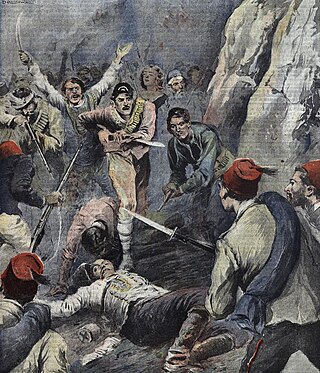
The Albanian revolt of 1910 was a reaction to the new centralization policies of the Young Turk Ottoman government in Albania. It was the first of a series of major uprisings. Rebels were supported by the Kingdom of Serbia. New taxes levied in the early months of 1910 led to Isa Boletini's activity to convince Albanian leaders who had already been involved in a 1909 uprising to try another revolt against the Ottoman Empire. The Albanian attacks on the Ottomans in Priştine and Ferizovik, the killing of the Ottoman commander in İpek, and the insurgents' blocking of the railway to Skopje at the Kaçanik Pass led to the Ottoman government's declaration of martial law in the area.
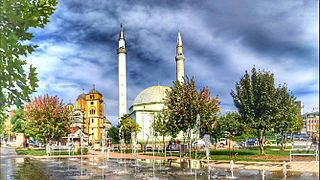
Ferizaj, or Uroševac, is the sixth largest city in Kosovo by population and seat of Ferizaj Municipality and Ferizaj District.
Vlashnjë is a village in the Prizren municipality of Kosovo. It has 1,700 inhabitants as of 2011. Vlashnjë is a multi-layered settlement and site area. Archaeological excavations have identified habitation and use of the area since the Neolithic era. The rock art paintings at Mrrizi i Kobajës are the first find of prehistoric rock art in Kosovo. In late antiquity, Vlashnja was a fortified settlement part of the fortification network which Justinian I rebuilt along the White Drin in Dardania.
Kosovo has a rich heritage in archaeology, however the field suffers from a lack of substantial institutional research. Since prehistory, the advantageous geostrategic position and abundant natural resources of the area have been suitable for the emergence of life. This is shown by the by traces of hundreds of archaeological sites discovered throughout the country, displaying the abundant archaeological legacy.
Ferizaj is a city and municipality in southern Kosovo, located 38 kilometers (24 mi) south of the capital city, Pristina. Ferizaj is the third most populated city in Kosovo, after Pristina and Prizren. It is the administrative centre of the homonymous district. The central city postal code is 70 000, and the currency is euro (€).
Ferizaj, the fifth largest city in Kosovo, has been populated since the pre-historic era. The history of Ferizaj is significant due to its impact on the economic, political, social culture of the region from antiquity to the present.

The R 6 Motorway, also commonly Autostrada Prishtinë-Han i Elezit and Autostrada Prishtinë-Shkup or Autostrada Arbën Xhaferi, is a motorway in Kosovo running 60 kilometres (37 mi) in the districts of Ferizaj and Pristina. The motorway connects Pristina with Skopje in North Macedonia.
